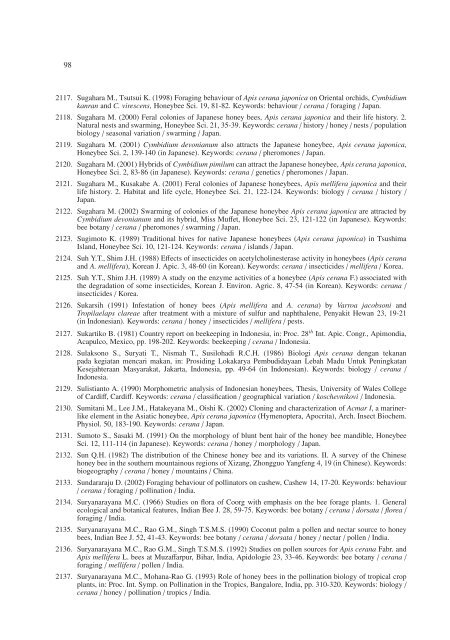Bibliography of Apis cerana Fabricius - Apidologie
Bibliography of Apis cerana Fabricius - Apidologie
Bibliography of Apis cerana Fabricius - Apidologie
Create successful ePaper yourself
Turn your PDF publications into a flip-book with our unique Google optimized e-Paper software.
98<br />
2117. Sugahara M., Tsutsui K. (1998) Foraging behaviour <strong>of</strong> <strong>Apis</strong> <strong>cerana</strong> japonica on Oriental orchids, Cymbidium<br />
kanran and C. virescens, Honeybee Sci. 19, 81-82. Keywords: behaviour / <strong>cerana</strong> / foraging / Japan.<br />
2118. Sugahara M. (2000) Feral colonies <strong>of</strong> Japanese honey bees, <strong>Apis</strong> <strong>cerana</strong> japonica and their life history. 2.<br />
Natural nests and swarming, Honeybee Sci. 21, 35-39. Keywords: <strong>cerana</strong> / history / honey / nests / population<br />
biology / seasonal variation / swarming / Japan.<br />
2119. Sugahara M. (2001) Cymbidium devonianum also attracts the Japanese honeybee, <strong>Apis</strong> <strong>cerana</strong> japonica,<br />
Honeybee Sci. 2, 139-140 (in Japanese). Keywords: <strong>cerana</strong> / pheromones / Japan.<br />
2120. Sugahara M. (2001) Hybrids <strong>of</strong> Cymbidium pimilum can attract the Japanese honeybee, <strong>Apis</strong> <strong>cerana</strong> japonica,<br />
Honeybee Sci. 2, 83-86 (in Japanese). Keywords: <strong>cerana</strong> / genetics / pheromones / Japan.<br />
2121. Sugahara M., Kusakabe A. (2001) Feral colonies <strong>of</strong> Japanese honeybees, <strong>Apis</strong> mellifera japonica and their<br />
life history. 2. Habitat and life cycle, Honeybee Sci. 21, 122-124. Keywords: biology / <strong>cerana</strong> / history /<br />
Japan.<br />
2122. Sugahara M. (2002) Swarming <strong>of</strong> colonies <strong>of</strong> the Japanese honeybee <strong>Apis</strong> <strong>cerana</strong> japonica are attracted by<br />
Cymbidium devonianum and its hybrid, Miss Muffet, Honeybee Sci. 23, 121-122 (in Japanese). Keywords:<br />
bee botany / <strong>cerana</strong> / pheromones / swarming / Japan.<br />
2123. Sugimoto K. (1989) Traditional hives for native Japanese honeybees (<strong>Apis</strong> <strong>cerana</strong> japonica) in Tsushima<br />
Island, Honeybee Sci. 10, 121-124. Keywords: <strong>cerana</strong> / islands / Japan.<br />
2124. Suh Y.T., Shim J.H. (1988) Effects <strong>of</strong> insecticides on acetylcholinesterase activity in honeybees (<strong>Apis</strong> <strong>cerana</strong><br />
and A. mellifera), Korean J. Apic. 3, 48-60 (in Korean). Keywords: <strong>cerana</strong> / insecticides / mellifera / Korea.<br />
2125. Suh Y.T., Shim J.H. (1989) A study on the enzyme activities <strong>of</strong> a honeybee (<strong>Apis</strong> <strong>cerana</strong> F.) associated with<br />
the degradation <strong>of</strong> some insecticides, Korean J. Environ. Agric. 8, 47-54 (in Korean). Keywords: <strong>cerana</strong> /<br />
insecticides / Korea.<br />
2126. Sukarsih (1991) Infestation <strong>of</strong> honey bees (<strong>Apis</strong> mellifera and A. <strong>cerana</strong>) by Varroa jacobsoni and<br />
Tropilaelaps clareae after treatment with a mixture <strong>of</strong> sulfur and naphthalene, Penyakit Hewan 23, 19-21<br />
(in Indonesian). Keywords: <strong>cerana</strong> / honey / insecticides / mellifera / pests.<br />
2127. Sukartiko B. (1981) Country report on beekeeping in Indonesia, in: Proc. 28th Int. Apic. Congr., Apimondia,<br />
Acapulco, Mexico, pp. 198-202. Keywords: beekeeping / <strong>cerana</strong> / Indonesia.<br />
2128. Sulaksono S., Suryati T., Nismah T., Susilohadi R.C.H. (1986) Biologi <strong>Apis</strong> <strong>cerana</strong> dengan tekanan<br />
pada kegiatan mencari makan, in: Prosiding Lokakarya Pembudidayaan Lebah Madu Untuk Peningkatan<br />
Kesejahteraan Masyarakat, Jakarta, Indonesia, pp. 49-64 (in Indonesian). Keywords: biology / <strong>cerana</strong> /<br />
Indonesia.<br />
2129. Sulistianto A. (1990) Morphometric analysis <strong>of</strong> Indonesian honeybees, Thesis, University <strong>of</strong> Wales College<br />
<strong>of</strong> Cardiff, Cardiff. Keywords:<strong>cerana</strong> / classification / geographical variation / koschevnikovi / Indonesia.<br />
2130. Sumitani M., Lee J.M., Hatakeyana M., Oishi K. (2002) Cloning and characterization <strong>of</strong> Acmar I, amarinerlike<br />
element in the Asiatic honeybee, <strong>Apis</strong> <strong>cerana</strong> japonica (Hymenoptera, Apocrita), Arch. Insect Biochem.<br />
Physiol. 50, 183-190. Keywords: <strong>cerana</strong> / Japan.<br />
2131. Sumoto S., Sasaki M. (1991) On the morphology <strong>of</strong> blunt bent hair <strong>of</strong> the honey bee mandible, Honeybee<br />
Sci. 12, 111-114 (in Japanese). Keywords: <strong>cerana</strong> / honey / morphology / Japan.<br />
2132. Sun Q.H. (1982) The distribution <strong>of</strong> the Chinese honey bee and its variations. II. A survey <strong>of</strong> the Chinese<br />
honey bee in the southern mountainous regions <strong>of</strong> Xizang, Zhongguo Yangfeng 4, 19 (in Chinese). Keywords:<br />
biogeography / <strong>cerana</strong> / honey / mountains / China.<br />
2133. Sundararaju D. (2002) Foraging behaviour <strong>of</strong> pollinators on cashew, Cashew 14, 17-20. Keywords: behaviour<br />
/ <strong>cerana</strong> / foraging / pollination / India.<br />
2134. Suryanarayana M.C. (1966) Studies on flora <strong>of</strong> Coorg with emphasis on the bee forage plants. 1. General<br />
ecological and botanical features, Indian Bee J. 28, 59-75. Keywords: bee botany / <strong>cerana</strong> / dorsata / florea /<br />
foraging / India.<br />
2135. Suryanarayana M.C., Rao G.M., Singh T.S.M.S. (1990) Coconut palm a pollen and nectar source to honey<br />
bees, Indian Bee J. 52, 41-43. Keywords: bee botany / <strong>cerana</strong> / dorsata / honey / nectar / pollen / India.<br />
2136. Suryanarayana M.C., Rao G.M., Singh T.S.M.S. (1992) Studies on pollen sources for <strong>Apis</strong> <strong>cerana</strong> Fabr. and<br />
<strong>Apis</strong> mellifera L. bees at Muzaffarpur, Bihar, India, <strong>Apidologie</strong> 23, 33-46. Keywords: bee botany / <strong>cerana</strong> /<br />
foraging / mellifera / pollen / India.<br />
2137. Suryanarayana M.C., Mohana-Rao G. (1993) Role <strong>of</strong> honey bees in the pollination biology <strong>of</strong> tropical crop<br />
plants, in: Proc. Int. Symp. on Pollination in the Tropics, Bangalore, India, pp. 310-320. Keywords: biology /<br />
<strong>cerana</strong> / honey / pollination / tropics / India.




